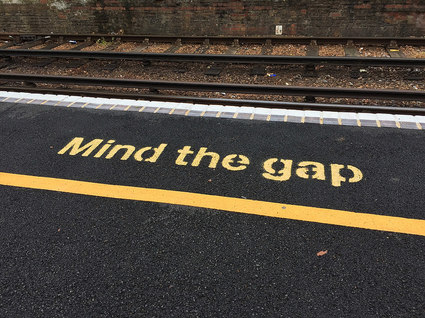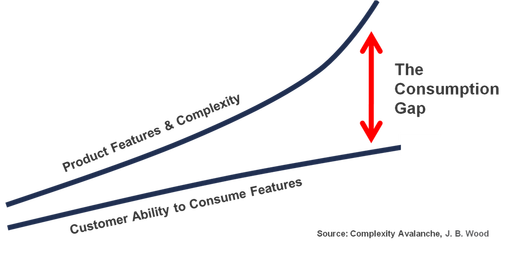|
Adam Joseph, Founder, CustomerSuccessManager.com At a recent Customer Success event, I was introduced to a concept called the “Consumption Gap” during a presentation by Dan Steinman from Gainsight. Although it was a term that I had not come across before, it’s not new; in fact, it was first coined by J.B. Wood in his book “Complexity Avalanche” back in 2009. The term perfectly describes the gap between what your product is capable of verses what your customers are using. :In other words, it’s all well and good having a truly innovative product with regularly scheduled product releases that add a tonne of new enhancements but can your users keep up? Do they have the knowledge, skills and most of all, time to take advantage of these new features or are they destined to gather “digital dust” forever more?
This gap is not just a business issue – it happens all around us in our professional and personal lives. One of the best personal illustrations that I can provide is the 65-inch Samsung TV which I purchased around 18 months ago and takes pride of place in my living room. This television was a purely luxury purchase however after extensive research, much deliberation and negotiating a good deal with the retailer, I decided to treat myself. Given the amount of time, effort and hard earned cash that I spent on this purchase you would think that I would be using the TV to its maximum capability? Absolutely not - in reality, I probably am only using about a quarter of what the TV is capable of. When I look at the remote control (which is about the length of my forearm), I have absolutely no idea about what half the buttons actually do. I just use my TV for the key tasks that I need and after using it for 18 months, I have no immediate desire to explore further. In this example, my “Consumption Gap” is around 75%. Following Dan’s excellent presentation on this subject, I was left with some fundamental questions about why the "Consumption Gap” exists that I wanted to expand on in this blog. Depending on the type of business and products that you provide there could be several reasons why the gap exists, however here are some keys ones:
When you consider that in the future, it is possible (and some might argue - probable) that today’s typical annual subscription model in the SaaS (Software as a Service) world will give way to an outcome based model where a provider only gets paid when the customer achieves their desired outcomes, the "Consumption Gap” will become even more important. Organisations who get complacent about their customers adopting as much of their products as possible will get replaced by nimbler competitors who have a strong Customer Success ethos and provide innovative, relevant, intuitive and feature-rich products that customers actually want and regularly use.
6 Comments
Jason Noble
18/6/2017 12:28:29 pm
Great post Adam, really brings the idea to light and it's something everyone can relate to.
Reply
Adam Joseph
18/6/2017 04:01:06 pm
Thanks Jason - glad you liked the blog and appreciate the feedback. Adam
Reply
Russell Gray
5/7/2017 07:24:42 pm
Another solid Blog Adam, I am really appreciating your content.
Reply
Robin Hayenga
1/7/2020 05:18:40 pm
Very helpful content - easy to consume.
Reply
26/4/2024 11:48:08 am
I appreciate the practical tips and strategies you've provided for closing the consumption gap, from improving onboarding processes to implementing ongoing customer education and support initiatives. These actionable insights will undoubtedly be valuable for businesses looking to enhance their customer success efforts.
Reply
Leave a Reply. |


